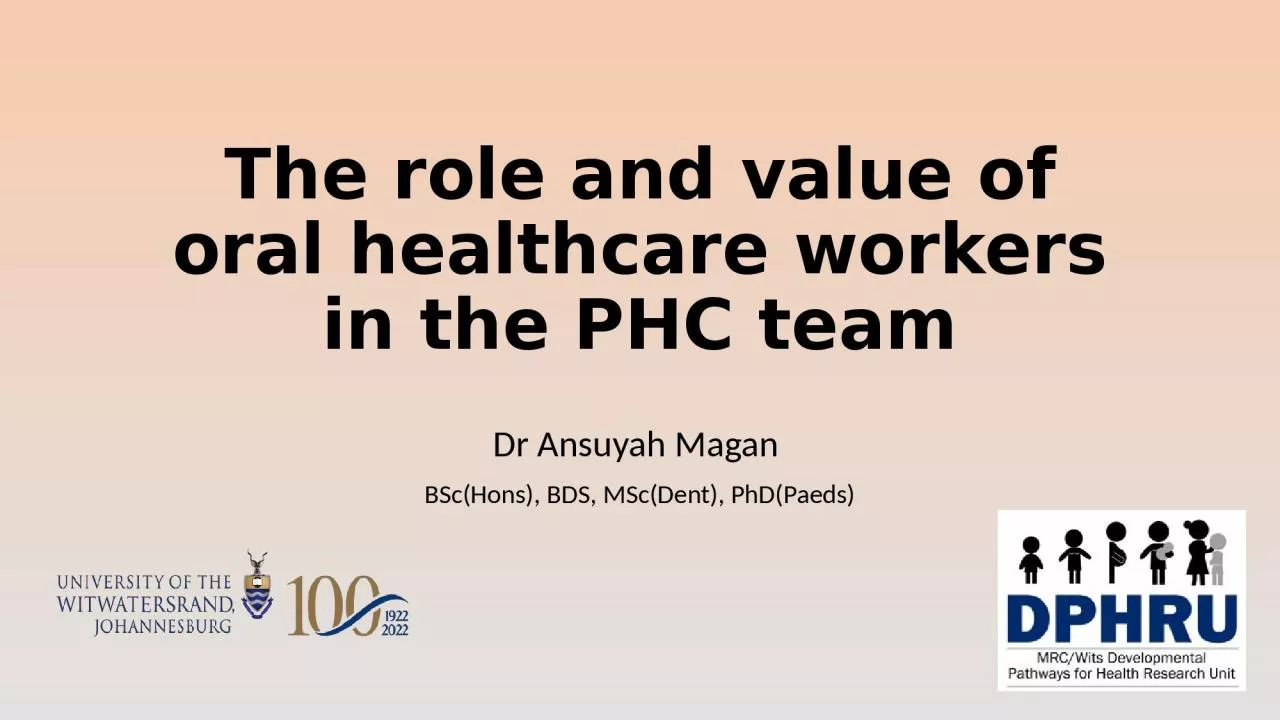

Dr Ansuyah Magan BScHons BDS MScDent PhDPaeds The Mouth Body Connection Source httpsgreencitydentalcom AIMS Oral health and General health Oral health and Primary health care ID: 1041748
Download Presentation The PPT/PDF document "The role and value of oral healthcare wo..." is the property of its rightful owner. Permission is granted to download and print the materials on this web site for personal, non-commercial use only, and to display it on your personal computer provided you do not modify the materials and that you retain all copyright notices contained in the materials. By downloading content from our website, you accept the terms of this agreement.
1. The role and value of oral healthcare workers in the PHC teamDr Ansuyah Magan BSc(Hons), BDS, MSc(Dent), PhD(Paeds)
2. The Mouth – Body ConnectionSource: https://greencitydental.com
3. AIMS Oral health and General health Oral health and Primary health care
4.
5. Source: American Dental Association https://www.mouthhealthy.orgCariesPeriodontal disease
6. Global Health CrisisGlobal Burden of Diseases Study (2015)Oral conditions affected 3.5 billion peopleUntreated caries in permanent teeth rated highest of all diseases (34.1%)Untreated caries in primary dentition (7.8%) Periodontal disease (7.4%)
7. South AfricaNational Oral Health Survey (NOHS) - 2002Age 6 years60% caries75.2% untreatedWestern Cape – low SES (n=659) Age 6 months – 6 years71.6% caries67.5% untreated (Mohamed et al, 2018) Johannesburg metropolitan area (n=459)Age 4 – 6 years44% caries97% untreated (Mothupi et al, 2016)
8. BacteriaCARIESSalivaImmunityFluorideOral hygieneSocioeconomic factorsCaries Aetiology
9. Periodontal disease (PD) - AetiologyPDPoor oral hygiene;Smoking;Excessive alcohol
10. Caries, Periodontitis and Non-communicable DiseasesModifiable Risk FactorsHigh sugars content in dietTobacco useExcessive alcohol usePathophysiologic PathwaysInflammationAltered host responsesAltered tissue homeostasis
11. WHO - Ten threats to global health (2019)Air pollution and climate changeNoncommunicable diseasesGlobal Influenza PandemicFragile and vulnerable settingsAntimicrobial resistanceEbola and other high-threat pathogensWeak primary health careVaccine hesitancyDengueHIV
12. The Kota – the most popular fast food in SowetoSource: Nearly Born Free. Strategic Marketing Kasi Style – Ingwazi and Chips. 2014. https://nearlybornfree.wordpress.com/
13. Nutrition transition – Double burden of malnutrition
14. Double burden of malnutrition: Causes and effects across the lifecourse Shrimpton et al (2012) www.worldbank.org/hnppublications
15. Maternal oral health during pregnancySaliva composition and flow rate vary more cariogenic environmentFluctuations in oestrogen and progesterone inflammatory mediators vascular permeability connective tissue turnover Poor oral hygiene Caries Periodontal disease
16. DiabetesCardiovascular diseaseCerebrovascular diseaseLow birthweightSmall for gestational agePreterm birthAdverse birth outcomesMaternal outcomesPhoto source: Zasciurinskiene, E (2018) PhD thesis, Jonkoping University, LithuaniaThe Effects of Maternal Periodontal Disease
17. Periodontal disease and adverse birth outcomesTurton and Africa (2017)442 pregnant women (74% had PD)75.5% mothers with severe PD had low birthweight infants severity PD – mean gestational ageBi et al (2021)20 Randomised control trials (N= 8171)Maternal periodontal therapy Reduced risk preterm birth Increase in birthweight
18. Early childhood caries (ECC)Source: www.momspresso.com
19. EARLY CHILDHOOD CARIESProlonged breastfeedingPoor nutritionMaternal biological, socioeconomic, and demographic factors Enamel hypoplasiaPremature tooth lossMalocclusionAltered jaw bone growth patternPoor oral health related quality of lifeAirway & breathing dysfunctionObesityHyperlipidaemiaSystemic hypertensionVentricular hypertrophyADHD and behavioural problemsPoor school performanceDepressionDecreased growth hormone secretionLinear growth affectedCopyright: Magan, A.
20. Early childhood caries, Malnutrition and Stunting Sokal-Gutierrez et al (2016) Rural Ecuador1575 children (6 months - 6 years) Intervention - educational, behavioural, clinical At Baseline >50% consumed junk dailyCaries prevalence: 1-yr-old group (53.8%)After 2 yearsJunk food consumption halvedCaries prevalence: 1-yr-old group (30.3%) Longitudinal subsample of 66 children <4 years39.5% reduction in stunting
21. Oral health personnel in South Africa Source: Bhayat A, Chikte U. Human resources for oral health care in South Africa: A 2018 update. Int J Environ Res Pub Health. 2019;16(10).10.3390/ijerph16101668
22. Recommendations - ResearchAdopt a common risk factor approach to address the determinants of oral diseases and NCDs.Oral disease prevention & management studies should adopt broader conceptual frameworks that include NCD-related biological, social and psychological factors.Cohort and intervention studies are required to establish the intergenerational effects of maternal factors on child oral and general health.
23. Source: USAID Africa Bureau
24. Thank You